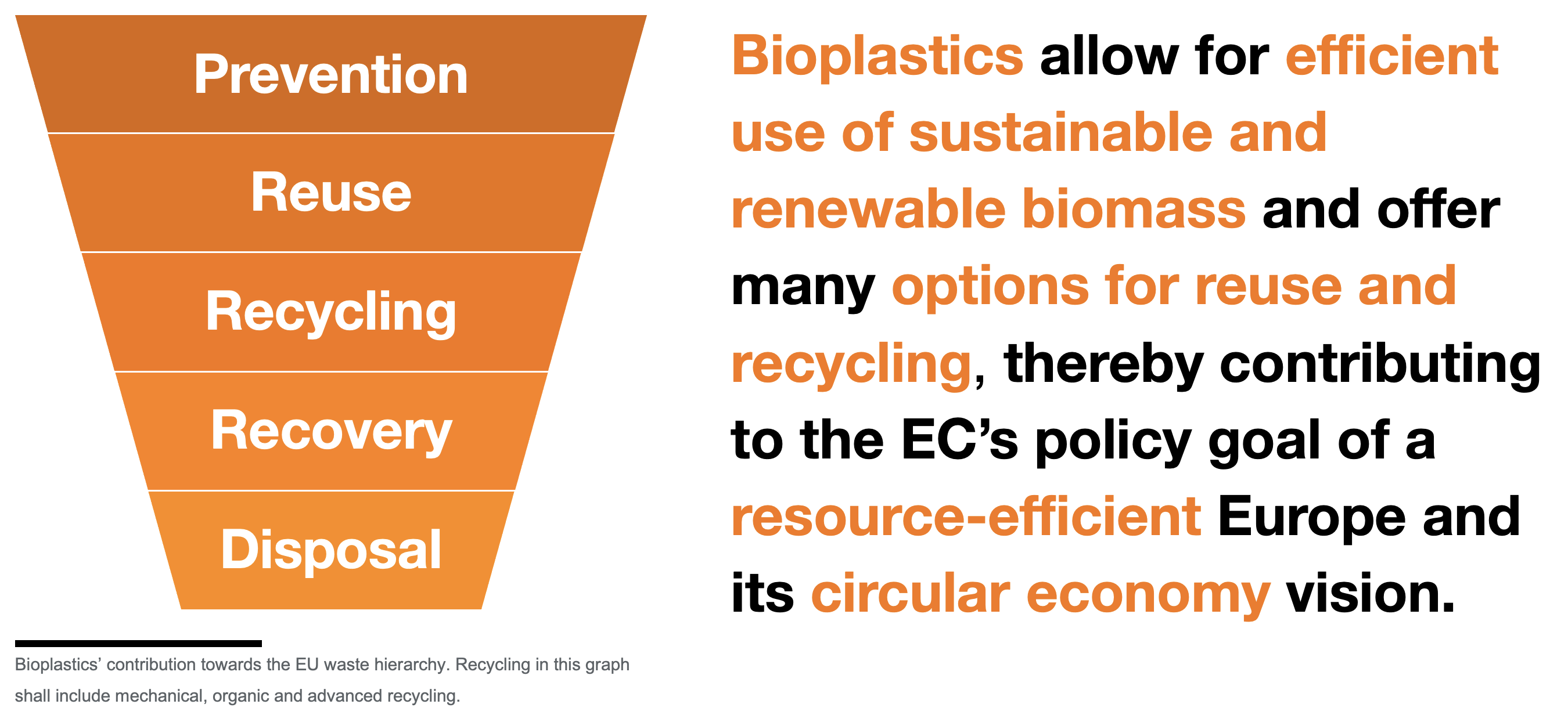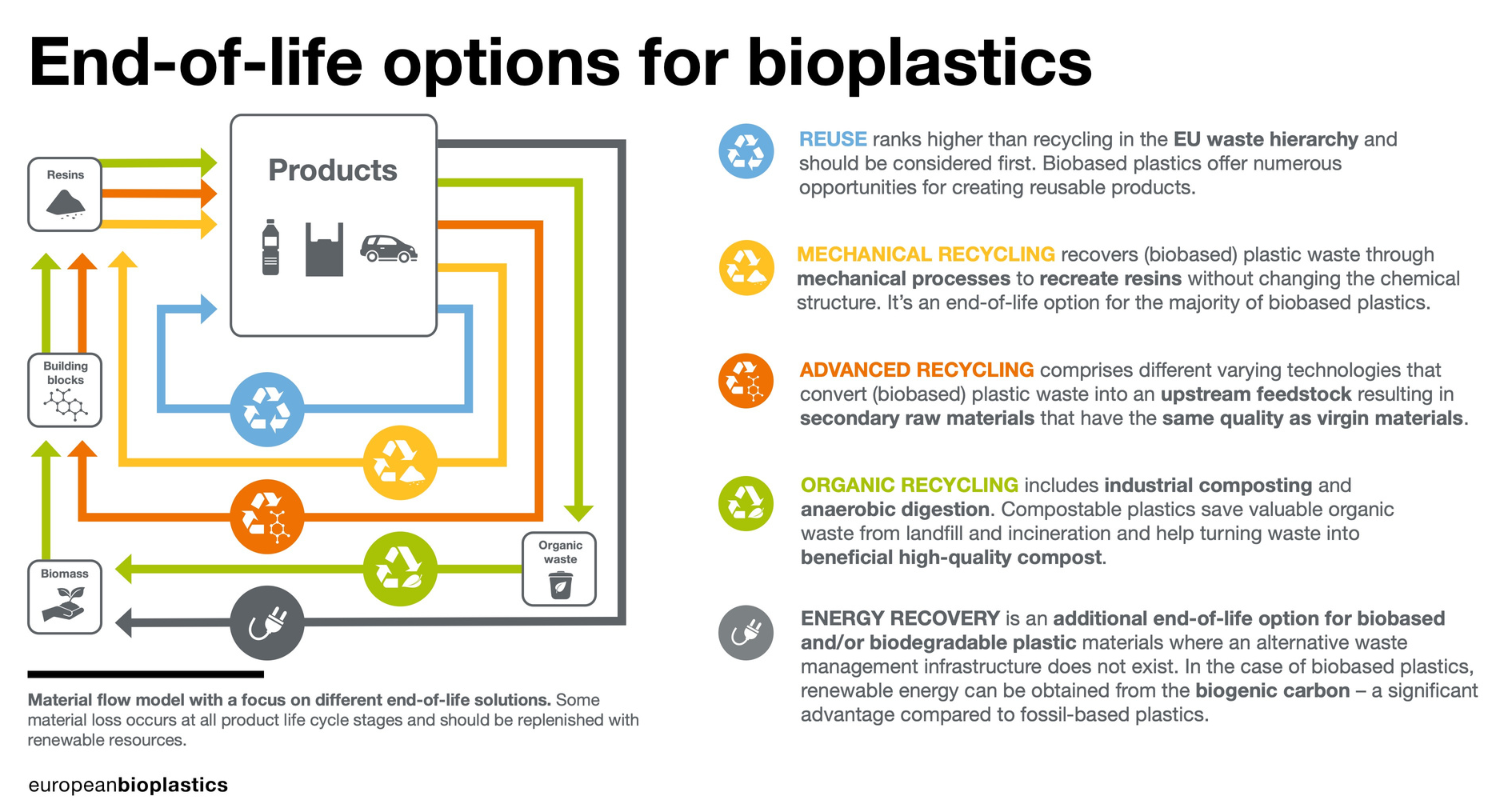Efficient waste management is key to the European Commission’s flagship policy goal of a resource-efficient Europe and its circular economy vision. The EU Waste Framework Directive (2008/98/EC, WFD) defines a five-step waste hierarchy ranking the different treatments of waste based on their ability to conserve resources. This hierarchy is applicable to all kinds of waste, including bioplastics waste.
The properties of the wide range of bioplastic materials make them suitable to be used in a large variety of applications. Bioplastics play an important role in achieving environmental goals such as providing lower carbon footprint products compared to fossil-based plastics, and additional end-of-life options.
Prevention
European Bioplastics supports a reduction in consumption of plastics. This step of the waste hierarchy requires manufacturing processes and materials that minimise resource exploitation. Just like conventional plastics, bioplastics are constantly being improved to meet those requirements. In this way, they have a positive impact on the overall amount of material required for certain applications. Furthermore, bioplastics offer a variety of innovative solutions, e.g., packaging with special properties to extend the shelf life of fresh produce and therefore help to reduce food waste.
Reuse
There are many reuse scenarios for bioplastics, such as food containers, reusable coffee cups, and carrier bags. EUBP supports that products are designed with realistic reuse possibilities in mind.
Recycling
A product should always be designed with an efficient and appropriate end-of-life solution in mind that is scientifically proven to minimise its environmental impact. There is no one-fits-all solution. All recycling methods are complementary, and the choice for one of them depends on the specific application, location, the available waste management collection and sorting systems, the recycling technologies available, and the market value of the recycled product.
To have a good quality output, all the following steps are important and should be performed efficiently and with care: product design-for-recycling, collection, sorting, and defining the most effective recycling streams. In general, unwanted contamination of the recyclates is a symptom of poor sorting, independent of the material type. Unwanted contamination occurs and is still present in almost all recycled plastics today. To obtain high quality recycling streams, further improvement in design-for-recycling, collection and sorting is needed. Find out more about the different recycling routes for bioplastics:
Energy recovery
If mechanical, advanced, or organic recycling are not suitable or available, the next best option for biobased plastic waste, according to the EU waste hierarchy, is incineration with energy recovery. In such a case, renewable energy is being produced. The biobased material releases the carbon dioxide that was originally sequestered by the plants – unlike for fossil-based materials, no additional carbon is released into the atmosphere at the end-of-life stage – thus supporting the transition to a net-zero CO2 economy. This is a key advantage over fossil-based plastics incineration. In case no higher ranked end-of-life options are available, EUBP considers incineration with energy recovery as a viable end-of-life choice for biobased plastics due to its sequestered carbon neutrality and the production of renewable energy, which fits to the European energy and climate targets.
Landfill
According to Plastics Europe, almost 25% of plastics waste was still being sent to landfill in 2022. Most European countries are still very far from reducing their landfill to the target of less than 10% for 2035 as stated in the Landfill Directive (EU) 2028/850. Because of its inherent environmental risks, landfilling is the least desirable end-of-life option. EUBP advocates for the phase-out of landfilling for any plastic product (including biodegradables) in Europe and supports appropriate measures to expand recycling and recovery of all types of plastic waste, as set out in the Landfill Directive.
Find out more in our position paper on end-of-life options for bioplastic products.


